| {{{1}}} | |
 | |
| Alternative name | Ishan al-Bahriyat |
|---|---|
| Location | Al-Qādisiyyah Governorate, Iraq |
| Region | Mesopotamia |
| Coordinates | 31°53′06″N 45°16′07″E / 31.88500°N 45.26861°E / 31.88500; 45.26861 |
| Type | Settlement |
| History | |
| Periods | Early Dynastic, Isin-Larsa, Old Babylonian, Kassite, Neo-Babylonian |
| Site notes | |
| Excavation dates | 1924, 1926, 1973-1989 |
| Archaeologists | Stephen Herbert Langdon, Raymond P. Dougherty, Barthel Hrouda |
Isin (Sumerian: 𒉌𒋛𒅔𒆠, romanized: I3-si-in, modern Arabic: Ishan al-Bahriyat) is an archaeological site in Al-Qādisiyyah Governorate, Iraq which was the location of the Ancient Near East city of Isin, occupied from the late 4th millennium Uruk period up until at least the late 1st millennium BC Neo-Babylonian period. It lies about 40 km (25 mi) southeast of the modern city of Al Diwaniyah.
The tutelary deity of Isin, dating back to at least the Early Dynastic period, was the healing goddess Gula with a major temple (, E-gal-ma) sited there as well as smaller installations for the related gods of Ninisina and Sud.
Archaeology

Isin is located approximately 20 miles (32 km) south of the ancient city of Nippur. The site covers an area of about 150 hectares with a maximum height of about 10 meters.
By 1922 the site had been suggested as that of Isin. Ishan al-Bahriyat was visited by Stephen Herbert Langdon for a day to conduct a sounding, while he was excavating at Kish in 1924. He found inscribed bricks of Ishme-Dagan and Enlil-bani. Two years later Raymond P. Dougherty, on behalf of the American Schools of Oriental Research, conducted a two-day survey of the site finding inscribed bricks of Bur-Sin and Neo-Babylonian ruler Nebuchadnezzar II.
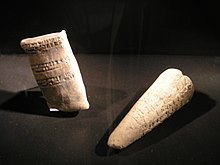
Right: Sumerian cuneiform "foundation stone". This clay cone was embedded in a wall, and contains the deed of foundation of the city walls of Isin (Tell Bahriyat) by king Ishme-Dagan of Isin (1953-1935 BC)
Modern archaeological work at Isin was accomplished in 11 seasons between 1973 and 1989 by a team of German archaeologists led by Barthel Hrouda on behalf of the Munich Institute for Near Eastern Archaeology. Hundreds of cuneiform tablets from the Old Babylonian period, in buildings abandoned after being destroyed by fire, were recovered. However, as was the case at many sites in Iraq, research was interrupted by the Gulf War (1990–1991) and the Iraq War (2003 to 2011). Since the end of excavations, extensive looting is reported to have resumed at the site. Even when the German team began their work, the site had already been heavily looted. A significant find, in the Ninurta shrine of the Gula temple, was an alabaster mace head of the Akkadian Empire ruler Manishtushu inscribed "Man-istusu, king of the world, dedicated (this mace) to the goddess Ninisina". An inscription of Takil-ilissu, ruler of Malgium was also found. Early find included a Jemdet Nasr stamp seal and a small stone lion figurine of the Uruk period.
The primary focus of the excavations was the four meter wide wall enclosed Gula temple complex. The complex showed construction through at least the Isin I, Kassite, and Neo-Babylonian periods with 3rd millennium BC finds suggested its earlier existence. Finds included 30 dog burials, copper pendants inscribed with dog images, and clay dog figurines, one with a prayer to Gula. An inscribed brick of Adad-apla-iddina, 8th ruler of the 2nd dynasty of Isin, dedicated to the healing goddess Nin-ezena was also found. On another section of the main mound 3rd millennium BC buildings provided "gold jewellery, bronze weapons, cylinder seals, and a few cuneiform tablets of which two date back to the Early Dynastic period", a clay nail of Isme-Dagan referring to construction of the bad-gal "Great Wall" city wall of Isin and an inscribed brick of Ur-du-kuga. In the Kassite layer an Early Dynastic III statue, 16.5 cm in height, of a kneeling man wearing only a triple belt. Just to the south of the temple complex two Early Dynastic I period buildings were found.
History
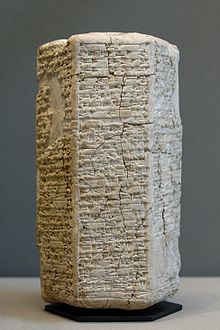
The site of Isin was occupied at least as early as the Ubaid period based on pottery shards. Significant occupation began in the Early Dynastic period in early to middle 3rd millennium BC. Isin is known to have been occupied during the Akkadian Empire. An intensive building program began at Isin during the Ur III empire in the late 3rd millennium BC. WIth the fall of Ur, an Amorite dynasty took power in the city, during the Isin-Larsa period. The city then fell to Babylon and suffered a period of abandonment. Activity resumed under the Kassites, followed by a period of local control. Isin was occupied to various degrees until the Neo-Babylonian period.
With the final decline of the Ur III empire at the end of the third millennium BC, a power vacuum was left that other city-states scrambled to fill. Ishbi-Erra, said to be an Amorite, from Mari, and an Ur III official under its final ruler Ibbi-Sin, gained rulership of Isin and began the First Dynasty of Isin. The Elamites had attacked Isin and Ur, capturing Ur. One of Ishbi-Erra's acts was to expel the Elamites from Ur and the region, his year name being "Year (Iszbi-Irra the king) brought out of Ur, with his strong weapon, the Elamite who was dwelling in its midst". Although the Sumerian King List gives a 33-year reign for Ishbi-Erra only one royal inscription has been found.
"For the god Enlil, lord of the foreign lands, his lord, Isbi-Err, mighty king, lord of <his> land, fashioned a great lyre for him, which ... the heart. He dedicated it life. The name of this lyre is 'Isbi-Erra trusts in the god Enlil'."
The Isin I dynasty lasted over two centuries. Its most powerful period was early on. With the rise of Larsa and a number of smaller Amorite city-states, the influence of Isin slowly declined. A notable ruler was Ishme-Dagan for whom a number of hymns were written, in a style thought to be imitative of Shulgi, the ruler of Ur III.
The exact events surrounding Isin's disintegration as a kingdom are mostly unknown, but some evidence can be pieced together. Documents indicate that access to water sources presented a huge problem for Isin. Isin also endured an internal coup of a sort when Gungunum the royally appointed governor of Larsa and Lagash province, seized the city of Ur. Ur had been the main center of the Gulf trade; thus this move economically devastated Isin. Additionally, Gungunum's two successors Abisare and Sumuel (c. 1905 BC and 1894 BC) both sought to cut Isin off from its canals by rerouting them into Larsa. At some point, Nippur was also lost. Isin would never recover. Around 1860 BC, an outsider named Enlil-bani seized the throne of Isin, ending the hereditary dynasty established by Ishbi-Erra over 150 years earlier.
Although politically and economically weak, Isin maintained its independence from Larsa for at least another forty years, ultimately succumbing to Larsa's ruler Rim-Sin I.
After the First Dynasty of Babylon rose to power in the early 2nd millennium and captured Larsa, much significant construction occurred at Isin. This ended with a destruction dated to around the 27th year of the reign of Samsu-iluna, son of Hammurabi, based on tablets found there.
Later, the Kassites who took over in Babylon after its sack in 1531 BC, resumed building at Isin. Activity was primarily at the Gula temple and it appears that in that period Isin was only a cult center. The final significant stage of activity occurred during the Second Dynasty of Isin at the end of the 2nd millennium, most notably by king Adad-apla-iddina. Isin remained occupied at least as late as the second decade of the reign of the Persian ruler Darius I (c 507 BC), then in the control of the region.
Of the at least 256 ruler year names about 75% have been found. Most have the standard format, aside from Bur-Sin who numbered his years. These year names combined with new tablet joins show that there were two additional rulers, Sumu-abum and Ikūn-pī-Išta, slotting in between Erra-imittī and Enlil-bān. The reign of Sumu-abum lasted less than a year.
Culture and literature

The city lay on the Isinnitum Canal, part of a set of waterways that connected the cities of Mesopotamia. The patron deity of Isin was Nintinuga (Gula) goddess of healing, and a temple to her was built there. The Isin king Enlil-bani reported building a temple to Gula named E-ni-dub-bi, a temple for Sud named E-dim-gal-an-na, a temple E-ur-gi-ra to Ninisina, as well as a temple for the god Ninbgal.
Ishbi-Erra continued many of the cultic practices that had flourished in the preceding Ur III period. He continued acting out the sacred marriage ritual each year. During this ritual, the king played the part of the mortal Dumuzi, and he had sex with a priestess who represented the goddess of love and war, Inanna (also known as Ishtar). This was thought to strengthen the king's relationship to the gods, which would then bring stability and prosperity on the entire country.
The Isin kings continued also the practice of appointing their daughters official priestesses of the moon god of Ur.
The literature of the period also continued in the line of the Ur III traditions when the Isin dynasty was first begun. For example, the royal hymn, a genre started in the preceding millennium, was continued. Many royal hymns written for the Isin rulers mirrored the themes, structure, and language of the Ur ones. Sometimes the hymns were written in the first person of a king's voice; other times, they were pleas of ordinary citizens meant for the ears of a king (sometimes an already dead one).
It was during this period that the Sumerian King List attained its final form, though it used many much earlier sources. The very compilation of the List seems to lead up to the Isin Dynasty itself, which would give it much legitimacy in the minds of the people because the dynasty would then be linked to earlier (albeit sometimes legendary) kings.
List of rulers
The Sumerian King List (SKL) gives a list of the rulers of only one dynasty of Isin. The first Sealand, Kassite, and second Isin dynasties are known from the Babylonian King List (BKL). The following list should not be considered complete:
| # | Portrait or inscription | Ruler | Approx. date and length of reign | Comments, notes, and references for mentions |
|---|---|---|---|---|
| Ur III period (c. 2119 – c. 2004 BC) | ||||
| First dynasty of Isin / Isin I dynasty (c. 2018 – c. 1792 BC) | ||||
| 1st | 
|
Ishbi-Erra 𒀭𒅖𒁉𒀴𒊏 |
r. c. 2018 – c. 1985 BC (MC) r. c. 1953 – c. 1921 BC |
|
| # | Portrait or inscription | Ruler | Approx. date and length of reign | Comments, notes, and references for mentions |
| Isin-Larsa period (c. 2004 – c. 1787 BC) | ||||
| ||||
| 2nd | 
|
Shu-Ilishu 𒋗𒉌𒉌𒋗 |
r. c. 1985 – c. 1975 BC (MC) r. c. 1920 – c. 1911 BC |
|
| 3rd | 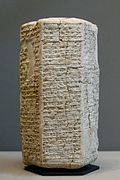
|
Iddin-Dagan 𒀭𒄿𒁷𒀭𒁕𒃶 |
r. c. 1975 – c. 1954 BC (MC) r. c. 1910 – c. 1890 BC |
|
| 4th | 
|
Ishme-Dagan 𒀭𒅖𒈨𒀭𒁕𒃶 |
r. c. 1954 – c. 1935 BC (MC) r. c. 1889 – c. 1871 BC |
|
| 5th | 
|
Lipit-Ishtar 𒇷𒁉𒀉𒁹𒁯 |
r. c. 1935 – c. 1924 BC (MC) r. c. 1870 – c. 1860 BC |
|
| 6th | 
|
Ur-Ninurta 𒀭𒌨𒀭𒊩𒌆𒅁 |
r. c. 1923 – c. 1896 BC (MC) r. c. 1859 – c. 1832 BC |
|
| 7th | 
|
Bur-Suen 𒀭𒁓𒀭𒂗𒍪 |
r. c. 1895 – c. 1874 BC (MC) r. c. 1831 – c. 1811 BC |
|
| 8th | Lipit-Enlil 𒀭𒇷𒁉𒀉𒀭𒂗𒆤 |
r. c. 1873 – c. 1868 BC (MC) r. c. 1810 – c. 1806 BC |
| |
| 9th | Erra-imitti 𒀭𒀴𒊏𒄿𒈪𒋾 |
r. c. 1868 – c. 1861 BC (MC) r. c. 1805 – c. 1799 BC |
| |
| 10th | Ikūn-pî-Ištar | r. c. 1861 – c. 1860 BC (MC) r. c. 1799 – c. 1798 BC |
| |
| 11th | Enlil-bani 𒀭𒂗𒆤𒁀𒉌 |
r. c. 1860 – c. 1836 BC (MC) r. c. 1798 – c. 1775 BC |
| |
| 12th | Zambiya 𒀭𒍝𒄠𒁉𒅀 |
r. c. 1836 – c. 1833 BC (MC) r. c. 1774 – c. 1772 BC |
| |
| 13th | Iter-pisha 𒀭𒄿𒋼𒅕𒅗𒊭 |
r. c. 1833 – c. 1829 BC (MC) r. c. 1771 – c. 1768 BC |
| |
| 14th | Ur-du-kuga 𒀭𒌨𒇯𒆬𒂵 |
r. c. 1829 – c. 1825 BC (MC) r. c. 1767 – c. 1764 BC |
| |
| 15th | Suen-magir 𒀭𒂗𒍪𒈠𒄫 |
r. c. 1825 – c. 1814 BC (MC) r. c. 1763 – c. 1753 BC |
| |
| 16th | 
|
Damiq-ilishu 𒁕𒈪𒅅𒉌𒉌𒋗 |
r. c. 1814 – c. 1792 BC (MC) r. c. 1752 – c. 1730 BC |
|
| ||||
| # | Portrait or inscription | Ruler | Approx. date and length of reign | Comments, notes, and references for mentions |
| Dynasty of Larsa (c. 1792 – c. 1787 BC) | ||||

|
Rim-Sîn I 𒀭𒊑𒅎𒀭𒂗𒍪 |
r. c. 1792 – c. 1787 BC (MC) |
| |
| # | Portrait or inscription | Ruler | Approx. date and length of reign | Comments, notes, and references for mentions |
| Old Babylonian period (c. 1787 – c. 1475 BC) | ||||
| First dynasty of Babylon (c. 1787 – c. 1732 BC) | ||||

|
Hammurabi 𒄩𒄠𒈬𒊏𒁉 |
r. c. 1787 – c. 1750 BC (MC) |
| |

|
Samsu-iluna 𒊓𒄠𒋢𒄿𒇻𒈾 |
r. c. 1750 – c. 1732 BC (MC) |
| |
| # | Portrait or inscription | Ruler | Approx. date and length of reign | Comments, notes, and references for mentions |
| First Sealand dynasty / Sealand I (c. 1732 – c. 1475 BC) | ||||
| Iliman | r. c. 1732 – c. 1700 BC (MC) r. c. 1700 BC |
| ||
| Ittili | r. c. 1700 – c. 1683 BC (MC) (56 years) |
| ||
| Unknown | r. c. 1683 – c. 1677 BC (MC) |
| ||
| Damqi-ilishu II 𒁕𒈪𒅅𒉌𒉌𒋗 |
r. c. 1677 – c. 1642 BC (MC) (26 years) |
| ||
| Ishkibal | r. c. 1641 – c. 1617 BC (MC) (15 years) |
| ||
| Shushushi | r. c. 1616 BC (MC) (24 years) |
| ||
| Gulkishar | Uncertain (MC) (55 years) |
| ||
| Gishen | Uncertain (MC) |
| ||
| Peshgaldaramesh | r. c. 1599 – c. 1549 BC (MC) (50 years) |
| ||
| Ayadaragalama 𒀀𒀀𒁰𒃴𒈠 |
r. c. 1548 – c. 1520 BC (MC) (28 years) |
| ||
| Ekurul | r. c. 1519 – c. 1493 BC (MC) (26 years) |
| ||
| Melamma | r. c. 1492 – c. 1485 BC (MC) (7 years) |
| ||
| Eaga | r. c. 1484 – c. 1475 BC (MC) r. c. 1460 BC |
| ||
| # | Portrait or inscription | Ruler | Approx. date and length of reign | Comments, notes, and references for mentions |
| Middle Babylonian period (c. 1475 – c. 1000 BC) | ||||
| Kassite dynasty (c. 1475 – c. 1155 BC) | ||||
| Agum III | r. c. 1475 BC (MC) |
| ||
| Kadashman-Sah | r. c. 1470 BC (MC) |
|||

|
Karaindash | r. c. 1415 BC (MC) |
| |
| Kadashman-Harbe I | r. c. 1410 BC (MC) |
| ||

|
Kurigalzu I | r. c. 1400 BC (MC) |
| |

|
Kadashman-Enlil I 𒅗𒁕𒀸𒈠𒀭𒀭𒂗𒆤 |
r. c. 1374 – c. 1360 BC (MC) (14 years) |
| |

|
Burna-Buriash II 𒁓𒈾𒁍𒊑𒅀𒀸 |
r. c. 1360 – c. 1333 BC (MC) (27 years) |
| |
| Kara-hardash | r. c. 1333 BC (MC) |
| ||
| Nazi-Bugash | r. c. 1333 BC (MC) |
|||

|
Kurigalzu II | r. c. 1333 – c. 1308 BC (MC) (25 years) |
| |

|
Nazi-Maruttash | r. c. 1308 – c. 1282 BC (MC) (26 years) |
| |
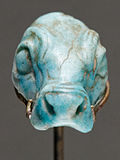
|
Kadashman-Turgu | r. c. 1282 – c. 1264 BC (MC) (18 years) |
| |

|
Kadashman-Enlil II | r. c. 1264 – c. 1255 BC (MC) (9 years) |
| |
| Kudur-Enlil | r. c. 1255 – c. 1246 BC (MC) (9 years) |
| ||

|
Shagarakti-Shuriash | r. c. 1246 – c. 1233 BC (MC) (13 years) |
| |

|
Kashtiliash IV | r. c. 1233 – c. 1225 BC (MC) (8 years) |
| |
| Enlil-nadin-shumi | r. c. 1224 BC (MC) (1 year and 6 months) |
|||
| Kadashman-Harbe II | r. c. 1223 BC (MC) (1 year and 6 months) |
|||

|
Adad-shuma-iddina | r. c. 1223 – c. 1217 BC (MC) (6 years) |
||

|
Adad-shuma-usur | r. c. 1217 – c. 1187 BC (MC) (30 years) |
| |

|
Meli-Shipak II | r. c. 1187 – c. 1172 BC (MC) (15 years) |
| |

|
Marduk-apla-iddina I | r. c. 1172 – c. 1159 BC (MC) (13 years) |
| |

|
Zababa-shuma-iddin | r. c. 1159 – c. 1158 BC (MC) (1 year) |
||

|
Enlil-nadin-ahi | r. c. 1158 – c. 1155 BC (MC) (3 years) |
||
| # | Portrait or inscription | Ruler | Approx. date and length of reign | Comments, notes, and references for mentions |
| Second dynasty of Isin / Isin II dynasty (c. 1153 – c. 1022 BC) | ||||
| Marduk-kabit-ahheshu | r. c. 1153 – c. 1135 BC (18 years) |
| ||

|
Itti-Marduk-balatu | r. c. 1135 – c. 1129 BC (MC) (6 years) |
| |
| Ninurta-nadin-shumi | r. c. 1129 – c. 1122 BC (MC) (7 years) |
| ||

|
Nebuchadnezzar I | r. c. 1122 – c. 1100 BC (MC) (22 years) |
| |

|
Enlil-nadin-apli | r. c. 1100 – c. 1096 BC (MC) (4 years) |
| |

|
Marduk-nadin-ahhe | r. c. 1096 – c. 1078 BC (MC) (18 years) |
| |
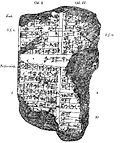
|
Marduk-shapik-zeri | r. c. 1078 – c. 1065 BC (MC) (13 years) |
| |
| Adad-apla-iddina | r. c. 1065 – c. 1041 BC (MC) (24 years) |
| ||
| Marduk-ahhe-eriba | r. c. 1041 BC (MC) (6 months) |
| ||
| Marduk-zer-X | r. c. 1041 – c. 1029 BC (MC) (12 years) |
|||

|
Nabu-shum-libur | r. c. 1029 – c. 1022 BC (MC) (7 years) |
| |
See also
References
- ETCSL. Sumerian King List . Accessed 19 Dec 2010.
- Tsouparopoulou, Christina, "The Healing Goddess, Her Dogs and Physicians in Late Third Millennium BC Mesopotamia", Zeitschrift für Assyriologie und vorderasiatische Archäologie, vol. 110, no. 1, pp. 14-24, 2020
- "Excavations in Iraq 1975", Iraq, vol. 38, no. 1, pp. 69-70, 1976
- Langdon, S., "The Location of Isin", The Journal of the Royal Asiatic Society of Great Britain and Ireland, no. 3, pp. 430–31, 1922
- Stephen Langdon, "Excavations at Kish I (1923–1924)", 1924
- Dougherty, Raymond P., "An Archæological Survey in Southern Babylonia I", Bulletin of the American Schools of Oriental Research, no. 23, pp. 15–28, 1926
- Dougherty, Raymond P., "An Archæological Survey in Southern Babylonia (Continued)", Bulletin of the American Schools of Oriental Research, no. 25, pp. 5–13, 1927
- Dougherty, Raymond P., "Searching for Ancient Remains in Lower ’Irâq: Report of an Archaeological Survey Made in Southern Babylonia during the First Quarter of 1926", The Annual of the American Schools of Oriental Research, vol. 7, pp. 1–93, 1925
- "Excavations in Iraq 1973-74", Iraq, vol. 37, no. 1, pp. 57-58, 1975
- "Excavations in Iraq 1985-86", Iraq, vol. 49, pp. 239-240, 1987
- "Excavations in Iraq 1987-88", Iraq, vol. 51, pp. 256, 1989
- "Excavations in Iraq 1989–1990", Iraq, vol. 53, pp. 175-176, 1991
- Otto, A./B. Einwag, A. Al-Hussainy/J. Jawdat, Ch. Fink/H. Maaß, "Destruction and looting of archaeological sites between Fāra/Šuruppak and Išān Bahrīyāt/Isin. Damage assessment during the Fara regional survey project FARSUP", Sumer 64, pp. 35-48, 2018
- Douglas R. Frayne, "Akkad", The Sargonic and Gutian Periods (2334–2113), University of Toronto Press, pp. 5-218, 1993 ISBN 0-8020-0593-4
- "Excavations in Iraq 1983-84", Iraq, vol. 47, pp. 221, 1985
- "Excavations in Iraq 1977-78", Iraq, vol. 41, no. 2, pp. 150, 1979
- "Excavations in Iraq 1972-73", Iraq, vol. 35, no. 2, pp. 192, 1973
- Dunham, Sally, Review of "Isin-Išān-Baḥrīyāt, IV: Die Ergebnisse der Ausgrabungen 1986–1989 by B. Hrouda", Journal of the American Oriental Society, vol. 116, no. 1, pp. 131–33, 1996
- Foster., Benjamin R., "Archives and Record-keeping in Sargonic Mesopotamia", Zeitschrift für Assyriologie und Vorderasiatische Archäologie , vol. 72, no. 1, pp. 1-27, 1982
- Kaniuth, Kai, "Isin in the Kassite Period", Volume 2 Karduniaš. Babylonia under the Kassites 2, edited by Alexa Bartelmus and Katja Sternitzke, Berlin, Boston: De Gruyter, pp. 492-507, 2017
- Michalowski, Piotr, "The Royal Letters in Their Historical Setting 3: Ur, Isin, Kazallu, and the Final Decades of the Ur III State (Letters 21–24)", The Correspondence of the Kings of Ur: An Epistolary History of an Ancient Mesopotamian Kingdom, University Park, USA: Penn State University Press, pp. 170-215, 2011
- Vaughn E. Crawford, "An Ishbi-Irra Date Formula", Journal of Cuneiform Studies, vol. 2, no. 1, pp. 13-19, 1948
- Douglas Frayne, "ISIN", Old Babylonian Period (2003-1595 B.C.): Early Periods, Volume 4, Toronto: University of Toronto Press, pp. 5-106, 1990
- Frayne, D. R, "New light on the reign of Išme-Dagan", ZA 88, pp. 6-44, 1998
- ^ William W. Hallo, "The Last Years of the Kings of ISIN", Journal of Near Eastern Studies, vol. 18, no. 1, pp. 54-72, 1959
- Bloch, Yigal, "An Edomite in Isin", Individuals and Institutions in the Ancient Near East: A Tribute to Ran Zadok, edited by Uri Gabbay and Shai Gordin, Berlin, Boston: De Gruyter, pp. 229-241, 2021
- de Boer, Rients, "Studies on the Old Babylonian Kings of Isin and Their Dynasties with an Updated List of Isin Year Names", Zeitschrift für Assyriologie und Vorderasiatische Archäologie, vol. 111, no. 1, pp. 5-27, 2021
- Sigrist, Marcel, "Isin year names", Andrews University Press, 1988
- Jacobsen, Thorkild., "The Waters of Ur", Iraq, vol. 22, pp. 174–85, 1960
- A. Livingstone, "The Isin "Dog House" Revisited", Journal of Cuneiform Studies, vol. 40, no. 1, pp. 54-60, 1988
- M. B. Rowton, "The Date of the Sumerian King List", Journal of Near Eastern Studies, vol. 19, no. 2, pp. 156-162, 1960
Further reading
- Vaughn Emerson Crawford, "Sumerian economic texts from the first dynasty of Isin", Yale University Press, 1954
- Crisostomo, Jay, "Old Babylonian legal documents from Isin in the Hearst Museum of Anthropology, Berkeley", Revue d’assyriologie et d’archéologie orientale 112.1, pp. 103–121, 2018
- Goetze, A., "Date formula of Iddin-Dagān of Isin", JCS 19, pp. 56, 1965
- Hrouda, B. "Die Ausgrabungen in Isin 1973 Und 1974", Orientalia, vol. 45, pp. 116–19, 1976
- Barthel Hrouda, "Isan Bahriyat I. D. Ergebnisse d. Ausgrabungen 1973–1974 (Veroffentlichungen der Kommission zur Erschliessung von Keilschrifttexten)", In Kommission bei der C.H. Beck, 1977 ISBN 3-7696-0074-6
- Barthel Hrouda, "Isin, Isan Bahriyat II: Die Ergebnisse der Ausgrabungen 1975–1978 (Veroffentlichungen der Kommission zur Erschliessung von Keilschrifttexten)", In Kommission bei der C.H. Beck, 1981 ISBN 3-7696-0082-7
- Barthel Hrouda, Isin, "Isan Bahriyat III: Die Ergebnisse der Ausgrabungen 1983–1984 (Veroffentlichungen der Kommission zur Erschliessung von Keilschrifttexten)", In Kommission bei C.H. Beck, 1987 ISBN 3-7696-0089-4
- Barthel Hrouda, "Isin, Isan Bahriyat IV: Die Ergebnisse der Ausgrabungen, 1986–1989 (Veroffentlichungen der Kommission zur Erschliessung von Keilschrifttexten)", In Kommission bei C.H. Beck, 1992 ISBN 3-7696-0100-9
- Kaniuth, Kai. "Isin in the Kassite Period", Volume 2 Karduniaš. Babylonia under the Kassites 2, edited by Alexa Bartelmus and Katja Sternitzke, Berlin, Boston: De Gruyter, pp. 492–507, 2017
- Lieberman, Stephen J., "The years of Damiqilishu, king of Isin", Revue d'Assyriologie et d'archéologie orientale 76.2, pp. 97–117, 1982
- M. van de Mieroop, "Crafts in the Early Isin Period: A Study of the Isin Craft Archive from the Reigns of Isbi-Erra and Su-Illisu", Peeters Publishers, 1987 ISBN 90-6831-092-5
- Arno Poebel, "The Second Dynasty of Isin According to A New King-List Tablet ", Assyriological Studies 15, Chicago: University of Chicago Press, 1955
- Sternitzke, Katja, "Babylon in the Second Millennium BCE: New Insights on the Transitions from Old Babylonian to Kassite and Isin II Periods", Babylonia under the Sealand and Kassite Dynasties, edited by Susanne Paulus and Tim Clayden, Berlin, Boston: De Gruyter, pp. 125–145, 2020
- Wilcke, C., Edzard, D. O., Walker, C., Odzuck, S., & Sommerfeld, W., "Keilschrifttexte aus Isin-Išān Baḥrīyāt: Ergebnisse der Ausgrabungen der Deutschen Forschungsgemeinschaft unter der Schirmherrschaft der Bayerischen Akademie der Wissenschaften", Bayerische Akademie d. Wissenschaften, 2018
External links
- Archaeological Site Photographs of Isin at Oriental Institute Archived 2013-11-09 at the Wayback Machine
- Iraqi Looters Tearing Up Archaeological Sites Edmund L. Andrews. The New York Times, May 23, 2003.
- Isin
- Populated places established in the 3rd millennium BC
- Populated places disestablished in the 6th century BC
- States and territories established in the 20th century BC
- States and territories disestablished in the 18th century BC
- 1924 archaeological discoveries
- History of Al-Qādisiyyah Governorate
- Archaeological sites in Iraq
- Former populated places in Iraq
- Sumerian cities
- Isin-Larsa period
- City-states
- Former kingdoms